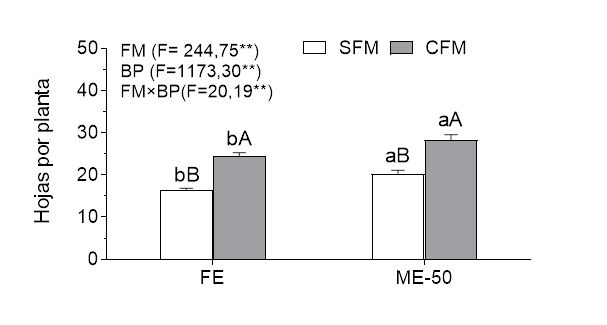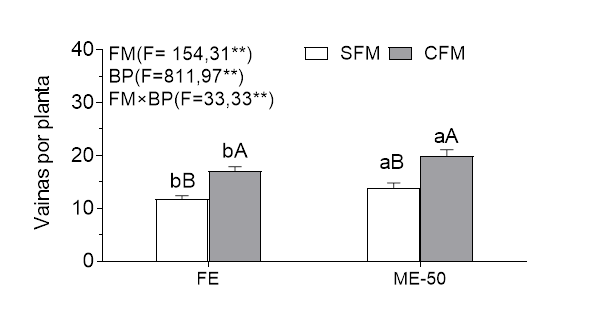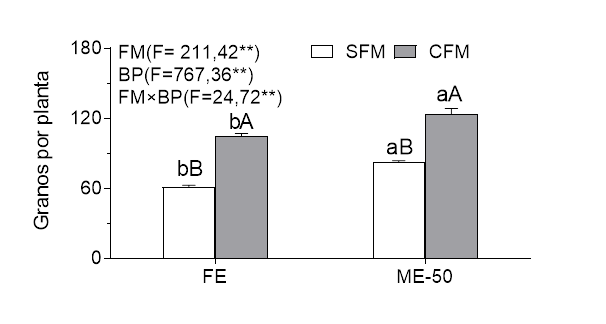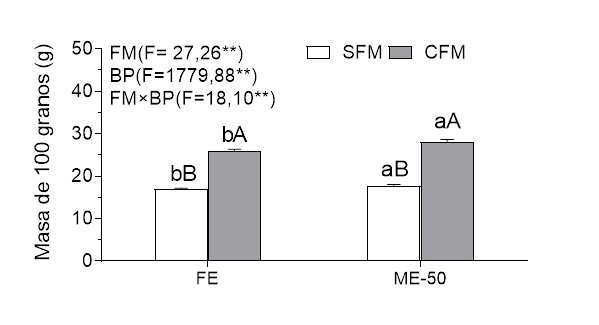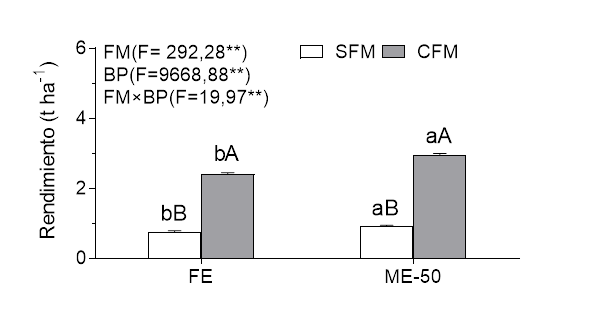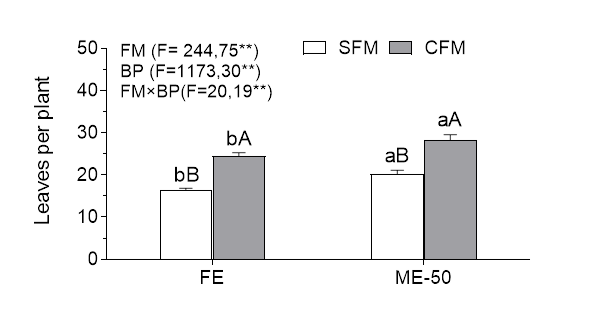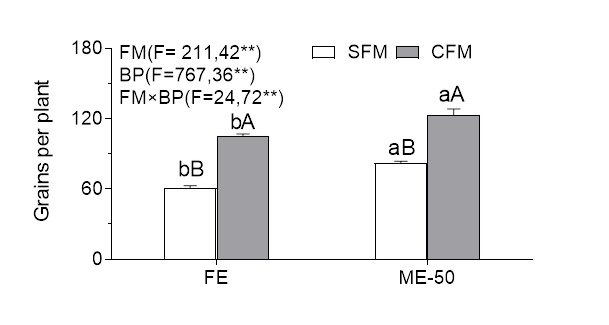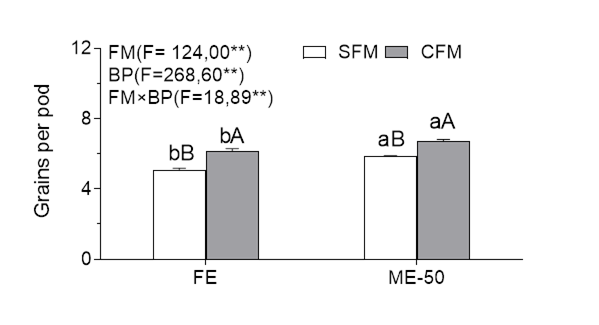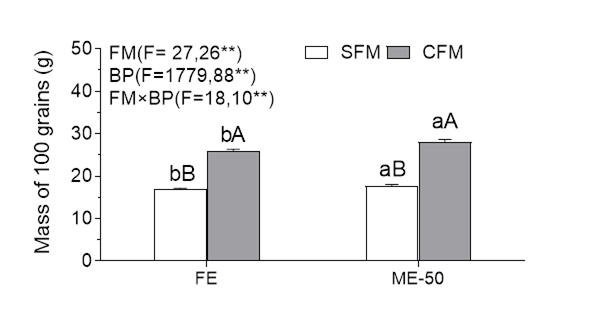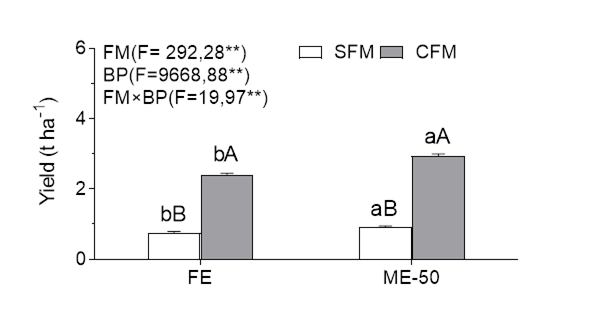Translate PaperArtículo originalAplicación complementaria de dos bioproductos incrementan la productividad del frijol común
[0000-0001-6536-2908] Alexander Calero-Hurtado [1] [*]
[0000-0003-4568-1981] Yanery Pérez-Díaz [2]
[0000-0001-7811-353X] Yainier González-Pardo Hurtado [3]
[0000-0002-7975-9508] Dilier Olivera-Viciedo [1]
[0000-0003-1200-2583] Kolima Peña-Calzada [1]
[0000-0002-6964-5160] Iván Castro-Lizazo [4]
[0000-0002-0662-8582] Jorge F. Meléndrez-Rodríguez [3]
[1] Universidade Estadual Paulista (UNESP), Faculdade de Ciências Agrarias e Veterinárias, Câmpus de Jaboticabal, São Paulo, Brasil
[2] Universidad
de Sancti Spíritus “José Martí Pérez” (UNISS). Centro Universitario
Municipal de Taguasco “Enrique José Varona”. Zaza del Medio, Taguasco,
Cuba
[3] Universidad de Sancti Spíritus “José Martí Pérez” (UNISS). Facultad de Ciencias Agropecuarias. Sancti Spíritus, Cuba
[4] Universidad
Agraria de La Habana “Fructuoso Rodríguez Pérez”, carretera a Tapaste y
Autopista Nacional. San José de las Lajas. Mayabeque, Cuba
[*] Autor para correspondencia: alexcalero34@gmail.com
RESUMENLa suplementación
con bioproductos (BP) puede constituir una alternativa eficiente para
el manejo de los cultivos, sobre todo en aquellos que se utilicen bajas
aplicaciones de fertilizantes minerales. El objetivo de este estudio fue
evaluar la aplicación complementaria de los bioproductos ME-50® y FitoMas-E®
(FE) en el aumento de la productividad del frijol común. Se realizó un
experimento en condiciones de campo con el cultivar ʻBat-304ʼ de frijol
común. Los tratamientos se distribuyeron en un diseño en bloques al
azar, en esquema factorial 2×2. Fueron estudiados dos niveles de
fertilización mineral (0 y 50 kg ha-1) y la aplicación de los bioproductos ME-50 (100 mL L-1) y FE (2 L ha-1),
con cinco repeticiones. A los 40 días después de la emergencia fue
determinado el promedio de hojas trifoliadas por planta y en la cosecha
fueron evaluados el número de vainas por planta, granos por planta,
granos por vaina, la masa de 100 granos y el rendimiento. Los resultados
mostraron que la aplicación de los bioproductos ME-50 y FitoMas-E
incrementaronlos parámetros morfofisiológicos y productivos del frijol,
con el consecuente incremento del rendimiento en presencia de la
fertilización mineral. Los resultados indicaron que el bioproducto ME-50
fue superior al FitoMas-E en ambas condiciones de cultivo. Este estudio
sugiere que la utilización de ambos bioproductos constituye una
contribución importante al manejo productivo de la especie porque mejora
los componentes productivos y consecuentemente el rendimiento.
INTRODUCCIÓNEl frijol común Phaseolus vulgaris
L., está considerado entrelas plantas de granos alimenticios, es una de
las especies más importantes para el consumo humano, porque en términos
nutricionales, constituyen una fuente barata de proteínas y minerales 1.
América Latina es la región con mayor producción del grano, pero al
mismo tiempo, la que más lo consume y se estima que más del 45 % de la
producción mundial proviene de esta región 2.
En Cuba, el P.vulgaris
constituye un alimento de la dieta básica diaria de las comidas. Es
cultivado en la mayoría de las provincias de forma convencional o
agroecológica, lográndose rendimientos de bajos a medios principalmente
dados por las condiciones climatológicas, la incidencia de plagas y el
manejo y aplicación de los fertilizantes orgánicos o minerales 3;
estos últimos, que afectan el medio ambiente, tanto por sus residuos en
los alimentos como por el efecto contaminante en los suelos y las
cuencas acuíferas 4.
El
desarrollo de sistemas que aseguren el uso eficiente de los
fertilizantes sin afectar el medio ambiente es crucial para mantener la
productividad de los cultivos en el futuro 5.
Bajas aplicaciones de fertilizantes minerales complementados con la
aplicación de bioproductos certifican una menor contaminación, ya que
los microorganismos transforman todas estas sustancias en nutrientes
asimilables para las plantas 6. Esta práctica aumenta la biomasa microbiana del suelo y los niveles de carbono y nitrógeno 7.
También hay mucho interés en mejorar el suministro de nutrientes para
los cultivos con las rizobacterias que promueven el crecimiento de las
plantas (PGPR). Los biofertilizantes que contienen PGPR muestran cada
vez más una promesa económica y un potencial de beneficios ambientales 8.
Actualmente
entre los bioproductosutilizados en la producción agropecuaria cubana,
se encuentra el FE desarrollado por el Instituto Cubano de
Investigaciones de los Derivados de la Caña de Azúcar (ICIDCA), este
bionutriente es portador de un conjunto de intermediarios bioquímicos de
alta energía extraordinariamente valioso para las plantas de cultivo,
lo cual se evidencia en la resistencia al estrés y se ve reflejado en el
incremento de los rendimientos y la mejora de la calidad de las
cosechas 9. Estos efectos beneficiosos con
la suplementación del FE han sido demostrados por varios investigadores
en el cultivo del frijol 10,11.
Por
otro lado, la tecnología de microorganismos eficientes (ME) también ha
causado impactos en la producción agrícola en más de 80 países 12. Su empleo ha beneficiado a los agricultores 13,
principalmente porque son introducidos un grupo de microorganismos
benéficos que mejoran las condiciones del suelo y con ello la
productividad de los cultivos 14. La
utilización de bioproductos constituidos en base a esta tecnología ha
favorecido la producción de varias especies, como el frijol común 15-19, la fresa 20, el pepino 21 y la habichuela 22.
Sin
embargo, en la producción actual del frijol, una estrategia importante
es la aplicación de fertilizantes minerales en el momento de la siembra y
continuar con la suplementación de bioproductos para incrementar la
productividad del grano. Por tanto, si son incrementados los indicadores
morfofisiológicos y productivos explicaría mejor el aumento del
rendimiento.
En vista de lo anterior, surgenlas
siguientes hipótesis: la aplicación complementaria de los bioproductos
ME-50 y FitoMas-E pueden constituir una alternativa eficiente para
aumentar la productividad del frijol común y todavía es posible
determinar cuál bioproducto favorece más el rendimiento de este cultivo.
En este sentido, el objetivo de la presente investigación fue evaluar
la aplicación complementaria de los bioproductos ME-50 y FitoMas-E en el
aumento de la productividad del frijol común.
MATERIALES Y MÉTODOSLa
siembra del cultivar de frijol común Bat-304 fue realizada en la
Cooperativa de Créditos y Servicios “Mártires de Taguasco”
(22°6ʹ17.588ʹʹN; 79°22ʹ33.544ʹʹO), Sancti Spíritus, Cuba, de noviembre
de 2016 a febrero de 2017. Las semillas del cv. Bat-304 fueron obtenidas
en la empresa de semilla de Sancti Spíritus con un 97 % de germinación,
el cual presenta granos de color negro, un rendimiento potencial de
2,77 t ha-1, hábito de crecimiento tipo III y un ciclo entre 75-85 días.
La
siembra se realizó de forma manual a la distancia de 0,60 m entre
hileras y 0,05 m entre plantas. Las variables climáticas fueron
registradas por la Estación Municipal de Recursos Hidráulicos de
Cabaiguán, la temperatura media diaria fue de 23,57 ± 2,80 ºC, la
humedad relativa 82,40 ± 6,50 % y la precipitación pluvial acumulada
durante el desarrollo de la investigación de 233,85 mm. El suelo fue
clasificado como Pardo Sialítico Carbonatado 23, denominado Cambisol 24.
El
diseño experimental fue en bloques al azar, distribuido en esquema
factorial 2×2. Fueron estudiados dos niveles de fertilización mineral
(FM) (0 y 50 kg ha-1) y la aplicación de los bioproductos ME-50 (100 mL L-1) y FE (2 L ha-1),
con cinco réplicas. La concentración de ME-50 utilizada para la
imbibición y las aplicaciones foliares fue seleccionada en base a los
resultados obtenidos anteriormente para este cultivo 18,25, mientras que la dosis de FE fue escogida a través de las orientaciones y resultados previos para el cultivo del frijol 10,17.
Las parcelas fueron de 7,20 m2 de tamaño, el área efectiva fue de 2,75 m2 y el área total del experimento de 0,08 ha. El modo de aplicación de los tratamientos se muestra en la Tabla 1, las semillas fueron embebidas durante 2 h en las soluciones de ambos bioproductos (Tabla 1),
después fueron colocadas en papel toalla para retirar el exceso de
humedad (~30 min) y rápidamente se procedió a la siembra de las mismas.
Las aplicaciones foliares de los bioproductos fueron realizadas con una
asperjadora manual (ECHO MS-21H) de 7,6 litros de capacidad, aplicados
en las etapas de fenológicas V3 y V4 (vegetativa) y la R5 (reproductiva)
y la fertilización mineral se realizó a la dosis de 50 kg ha-1 antes de la siembra con la fórmula completa (N, P, K) 9,13,18 (Tabla 1).
Las labores de cultivo se realizaron siguiendo las recomendaciones del instructivo técnico para el cultivo 3 y las labores de limpieza fueron realizadas de forma manual.
Los
bioproductos ME-50 y FE fueron adquiridos en la Sucursal de Labiofam de
Sancti Spíritus. El FitoMas-E es un derivado de la industria azucarera
cubana creado y desarrollado por el ICIDCA. Es una mezcla de sales
minerales y sustancias bioquímicas de alta energía (aminoácidos, bases
nitrogenadas, sacáridos y polisacáridos biológicamente activos), 150,0 g
L-1 de extracto orgánico, 55,0 g L-1 de Nitrógeno total, 60 g L-1 de K2O y 31,0 g L-1 de P2O5. El bioproducto ME-50 conocido como microorganismos eficientes, está compuesto principalmente por tres especies, como el Bacillus subtilis B/23-45-10 Nato (5,4 104 ucf mL-1), Lactobacillus bulgaricum B/103-4-1 (3,6 104 ucf mL-1) y Saccharomyces cereviciae L-25-7-12 (22,3 105 ucf mL-1), con certificado de calidad emitido por ICIDCA, código R-ID-B-Prot-01-01.
Las variables evaluadas correspondieron con los criterios descritos para el cultivo 26.
Los muestreos fueron realizados en el área efectiva de las parcelas y
evaluadas 40 plantas por tratamientos. En la etapa fenológica R5 fue
evaluado el número de hojas por planta (NH)y al finalizar el ciclo del
cultivo (R9) fueron evaluados el número vainas por planta (VP); el
número de granos por planta (GP); el número de granos por vaina (GV); la
masa promedio de 100 semillas (g) (M100) y el rendimiento (t ha-1).
Los datos obtenidos fueron procesados en el software estadístico AgroEstat®,
a los cuales se le determinó la distribución normal, mediante la prueba
de Shapiro-Wilk para la bondad de ajuste. Cuando existió normalidad fue
realizado un análisis de varianza de dos vías (ANOVA) y la
significancia de la varianza fue comprobada por la prueba de Fisher,
cuando esta fue significativa al 5 % de probabilidad de error, las
medias fueron comparadas por la prueba de Rangos Múltiples de Tukey
(p<0,05).
RESULTADOS Y DISCUSIÓNEl ANOVA reveló una interacción significativa (p<0,01) entre los factores FM y BP en el promedio de hojas por planta (Figura 1). La aplicación de ambos bioproductos en condiciones de FM (50 k ha-1)
incrementaron el número de HP en relación a las plantas sin FM
(p<0,01), con destaque para el tratamiento con ME-50 porque logró
mejor desempeño que el FE en ambas condiciones de FM. Cuando las plantas
de frijol fueron fertilizadas con (50 k ha-1) la aplicación
del ME-50incrementó el HP en ~40 % comparados con las plantas sin FM y
fue superior en 23 % a la aplicación del FE, pero al mismo tiempo la
aplicación de FE bajo FM incrementó el HP en 50 % comparado con las
plantas que no recibieron FM. Por otro lado, en condiciones de cultivo
sin FM la aplicación de ME-50 fue superior en ~24 % comparado con el FE (Figura 1).
En
este estudio fueron demostrados los efectos benéficos de la aplicación
de ambos bioproductos ME-50 y FE en la producción de HPdel cv. Bat-304.
Por tanto, se evidenció que la producción de frijol es perjudicada en
las condiciones actuales de manejo, principalmente porque no se favorece
la producción de HP. Sin embargo, la aplicación complementaria de ambos
bioproductos favoreció el número de HP (Figura 1).
Estos efectos benéficos de ambos bioproductos en el aumento del número
de HP fueron posibles porque son introducidos microorganismos y
sustancias que estimulan el crecimiento de las plantas 9,27.
El incremento del HP tiene una gran importancia fisiológica para el
vegetal, debido a la mayor superficie fotosintéticamente activa de la
planta, lo cual, favorece la elaboración de nutrimentos y otros procesos
metabólicos de las plantas 28.
Los resultados mostraron que la aplicación complementaria del ME-50 incrementó el HP en relación a la ausencia (Figura 1). Estos efectos pudieron estar influenciados por la incorporación de microorganismos como Bacillus subtilis, Lactobacillus bulgaricum y Saccharomyces cereviciae, los cuales ayudan a solubilizar y producir sustancias y nutrientes que favorecen la arquitectura de las plantas 14. Estos efectos benéficos de los ME en el aumento de la producción del HP fueron observados anteriormente en esta especie 15-19.
Por
otra parte, fue observado que la aplicación complementaria del FE
favoreció la producción de HP en el cv. Bat-304 en relación a la no
adición del bioproducto (Figura 1). Estos resultados
pudieron estar modificados porque este bionutriente incorporó una mezcla
de sales minerales y sustancias bioquímicas de alta energía, lo cual se
complementó muy bien con la baja FM mineral realizada en el aumento del
HP. Estos resultados son consistentes con otros estudios descritos
anteriormente 10,11,15, quienes informaron que el FE estimuló los indicadores morfológicos en las plantas de frijol.
Producción
de hojas trifoliadas por planta obtenidos en el cv. Bat-304 de frijol
común cultivado bajo dos niveles de FM (0 y 50 kg ha-1) combinados con la aplicación de los bioproductos ME-50 (100 mL L-1) y FE (2 L ha-1)
Valores representados por la media de cinco réplicas ± desviación estándar (DE) (Medias ± DE, n
= 5). Letras minúsculas indican diferencias entre los bioproductos en
el mismo nivel de fertilización mineral y letras mayúsculas diferentes
indican diferencias entre los niveles de fertilización mineral en el
mismo bioproducto, según Tukey (p<0,05). ME-50: microorganismos
eficientes; FE: FitoMas-E. SFM: sin fertilizante mineral; CFM: con
fertilizante mineral; FM × BP interacción fertilización
mineral-bioproductos. Valores de F, **significativo al 99 % de
probabilidad del error, de acuerdo al ANOVA
La producción de vainas por planta mostró una interacción significativa (p<0,01) entre los factores FM y BP (Figura 2). La aplicación de los bioproductos ME-50 y FE alcanzaron una mayor producción del VP bajo la FM con 50 kg ha-1
comparado con las plantas que fueron fertilizadas (p<0,01). El
tratamiento con ME-50 mostró un mejor resultado en el VP comparado con
el FE en ambas condiciones de FM y mostraron diferencias significativas
(p<0,01). En condiciones de FM el tratamiento con ME-50 incrementó el
VP en 17 % en relación al FE y fue superior en un 43 % en relación a
las plantas sin FM; sin embargo, las plantas de frijol que recibieron la
aplicación de FE y fertilizadas con 50 kg ha-1 de FC
incrementaron el promedio de VP en ~45 % comparadas con aquellas no
recibieron FE y FM. Por otro lado, cuando las plantas de frijol no
recibieron FM el ME-50 incrementó el VP en ~18 % comparado con la
aplicación de FE (Figura 2).
Los
resultados indicaron que la aplicación del ME-50 logró un mejor
desempeño en la producción de VP del cv. Bat-304 comparado con el FE,
independientemente de la adición o no del FM. Por tanto, estos efectos
superiores del tratamiento con ME-50 en el VP pudieron estar
influenciados por el incremento del HP (Figura 1). Estos hallazgos son consistentes con estudios anteriores 25,
quienes demostraron que, al incrementarse la arquitectura morfológica
de la planta, propició un incremento en la formación de inflorescencias
con el consiguiente incremento del VP. Este efecto benéfico de la
aplicación de este bioproducto en el incremento del VP fueron
demostrados previamente en plantas de frijol 15,16,18.
Este estudio demostró también que la aplicación de FE sobre las plantas de frijol cultivadas con 50 kg ha-1 de FM aumentó significativamente la producción del VP, especialmente cuando fue aplicado el FM (Figura 2). Estos resultados fueron posibles porque en estas condiciones el FE incrementó el HP (Figura 1).
Una posible explicación para estos resultados está dado por la
incorporación de diferentes sustancias presentes en el FE que estimulan
los parámetros morfológicos e productivos de las plantas 9. Los resultados obtenidos en este estudio son consistentes con los hallazgos reportados anteriormente 15,29, quienes incrementaron el VP en plantas de frijol con la aplicación de FE.
Producción de vainas por planta obtenidos en el cv. Bat-304 de frijol común cultivado bajo dos niveles de FM (0 y 50 kg ha-1) combinados con la aplicación de los bioproductos ME-50 (100 mL L-1) y FE (2 L ha-1). Medias ± DE, n = 5
Letras
minúsculas indican diferencias entre los bioproductos en el mismo nivel
de fertilización mineral y letras mayúsculas diferentes indican
diferencias entre los niveles de fertilización mineral en el mismo
bioproducto, según Tukey (p<0,05). ME-50: microorganismos eficientes;
FE: FitoMas-E. SFM: sin fertilizante mineral; CFM: con fertilizante
mineral; FM × BP interacción fertilización mineral-bioproductos. Valores
de F, **significativo al 99 % de probabilidad del error, de acuerdo al
ANOVA
El promedio de granos por planta obtenidos en
el cv. Bat-304 presentó una interacción significativa entre la FM y BP
(p<0,01) (Figura 3). La aplicación de los
bioproductos ME-50 y FE aumentaron significativamente el GP
independientemente de la adición o no de la FM (p<0,01). La
aplicación del ME-50 incrementó el GP en ~18 % con respecto al FE cuando
las plantas de frijol recibieron 50 kg ha-1 del FM y en ~35 % en ausencia del FM (Figura 3),
sin embargo, el tratamiento con ME-50 en presencia del FM aumentó el GP
en ~50 % comparado con la ausencia del FM, mientras que, el FE en
presencia del FM incrementó el GP en ~72 % respecto a la ausencia de la
FM (Figura 3).
Los resultados
de este estudio mostraron una fuerte evidencia del efecto de ambos
bioproductos en el incremento del GP en las plantas de frijol, pero la
aplicación del ME-50 fue significativamente superior al FE en las dos
condiciones de fertilización evaluadas (Figura 3). La respuesta de esta variable mantiene la tendencia del HP (Figura 1) y la del VP (Figura 2),
lo que evidencia el posible efecto de ambos bioproductos en el
incremento de los parámetros morfológicos y productivos del frijol. Los
resultados obtenidos en esta investigación con la aplicación del ME-50
son similares a los hallazgos encontrados anteriormente en frijol 15 y en la habichuela 22.
Por otra parte, los resultados alcanzados por la aplicación del FE en
el incremento este componente del rendimiento, fueron superiores en
presencia del FM comparado con la ausencia de este, lo que pudo estar
influenciado por el aumento del contenido de nutrientes para el
crecimiento y desarrollo de las plantas. Estos resultados benéficos de
la aplicación del FE son consistentes con los hallazgos reportados
anteriormente en plantas de frijol 29.
Producción de granos por planta obtenidos en el cv. Bat-304 de frijol común cultivado bajo dos niveles de FM (0 y 50 kg ha-1) combinados con la aplicación de los bioproductos ME-50 (100 mL L-1) y FE (2 L ha-1). Medias ± DE, n = 5
Letras
minúsculas indican diferencias entre los bioproductos en el mismo nivel
de fertilización mineral y letras mayúsculas diferentes indican
diferencias entre los niveles de fertilización mineral en el mismo
bioproducto, según Tukey (p<0,05). ME-50: microorganismos eficientes;
FE: FitoMas-E. SFM: sin fertilizante mineral; CFM: con fertilizante
mineral; FM × BP interacción fertilización mineral-bioproductos. Valores
de F, **significativo al 99 % de probabilidad del error, de acuerdo al
ANOVA
La producción de granos por vainas en plantas
del cv. Bat-304 de frijol común mostró una alta interacción
significativa entre la FM×BP (p<0,01) (Figura 4).
La aplicación de los dos bioproductos estimuló la producción de GV,
especialmente en la presencia de la FM. El tratamiento con ME-50
incrementó el GV comparados con la aplicación del FE, estos incrementos
fueron de ~12 % en presencia del FM y de ~12 % en la ausencia de la FM
(p<0,01). Sin embargo, en presencia del FM la aplicación del ME-50
aumentó el GV en ~15 % comparado con la ausencia del FM (p<0,01). Por
otro parte, la aplicación del FE en presencia del FM incrementó el GV
en ~20 % en relación a las plantas cultivadas en ausencia del FM (Figura 4).
Quedó
evidenciado que la aplicación de ambos bioproductos aumentó el promedio
de GV, principalmente debido a que esta variable también mantuvo la
tendencia de los parámetros anteriores como el HP, VP y GP (Figuras 1-3). Los resultados obtenidos mostraron que el tratamiento con ME-50 benefició la producción de GV en el cv. Bat-304 de frijol (Figura 4)
en las dos condiciones de fertilización estudiadas. Estos hallazgos
fueron consistentes con estudios previos en plantas de frijol 16-18 y la habichuela 22.
Por
otro lado, fue observado también que la aplicación del bioproducto FE
benefició el promedio de GV, en particular cuando fu e adicionado el FM.
Estos resultados están en línea con los resultados reportados
anteriormente 10,11,15, quienes informaron que el FE modificó este indicador productivo en plantas de frijol.
Producción de granos por vaina obtenido en el cv. Bat-304 de frijol común cultivado bajo dos niveles de FM (0 y 50 kg ha-1) combinados con la aplicación de los bioproductos ME-50 (100mL L-1) y FE (2 L ha-1). Medias ± DE, n = 5
Letras
minúsculas indican diferencias entre los bioproductos en el mismo nivel
de fertilización mineral y letras mayúsculas diferentes indican
diferencias entre los niveles de fertilización mineral en el mismo
bioproducto, según Tukey (p<0,05). ME-50: microorganismos eficientes;
FE: FitoMas-E. SFM: sin fertilizante mineral; CFM: con fertilizante
mineral; FM × BP interacción fertilización mineral-bioproductos. Valores
de F, **significativo al 99 % de probabilidad del error, de acuerdo al
ANOVA
La masa de 100 granos de frijol del cv. Bat-304 mostró una interacción significativa entre la FM y los BP (p<0,01) (Figura 5).
La aplicación de ambos bioproductos incrementó la M100 en las plantas
CFM comparado con las plantas SFM (p<0,01). Mientras que, el
tratamiento con ME-50 fue superior al FE en la M100 en ambas condiciones
de fertilización evaluadas, los incrementos fueron de ~10 % en la
presencia y de ~9 % en la ausencia, respectivamente (p<0,01). Por
otro lado, la aplicación de FE sobre las plantas CFM incrementó la M100
en ~53 % comparado con la ausencia del FM (Figura 5).
Este
estudio evidenció que la aplicación de los bioproductos ME-50 y FE
estimularon la M100 del cv. Bat-304 de frijol común, especialmente
cuando estas fueron cultivadas en presencia del FM, con destaque para el
tratamiento con ME-50 (Figura 5). Esta variable
mantuvo una tendencia similar a las respuestas observadas previamente en
los parámetros como el HP, VP, GP y GV (Figuras 1-4),
posiblemente porque estos fueron incrementados. Los resultados del
estudio actual estuvieron de acuerdo con los hallazgos observados
anteriormente en plantas frijol 15,16,18.
Por
otro lado, la aplicación del bioproducto FE logró un mejor desempeño en
el incremento del M100 en presencia del FM comparado con la no
aplicación del bionutriente (Figura 5), esto pudo estar influenciado principalmente por el incremento de los indicadores observados anteriormente (Figuras 1-4). Estos resultados son consistentes con los hallazgos reportados anteriormente en estudios previos en plantas de frijol 10,11,15.
Masa promedio de 100 granos obtenidos en el cv. Bat-304 de frijol común cultivado bajo dos niveles de FM (0 y 50 kg ha-1) combinados con la aplicación de los bioproductos ME-50 (100 mL L-1) y FE (2 L ha-1). Medias ± DE, n = 5
Letras
minúsculas indican diferencias entre los bioproductos en el mismo nivel
de fertilización mineral y letras mayúsculas diferentes indican
diferencias entre los niveles de fertilización mineral en el mismo
bioproducto, según Tukey (p<0,05). ME-50: microorganismos eficientes;
FE: FitoMas-E. SFM: sin fertilizante mineral; CFM: con fertilizante
mineral; FM × BP interacción fertilización mineral-bioproductos. Valores
de F, **significativo al 99 % de probabilidad del error, de acuerdo al
ANOVA
El rendimiento obtenido en las plantas de frijol mostró una interacción significativa entre el FM y los BP (p<0,01) (Figura 6).
La aplicación de ambos bioproductos incrementó la productividad del
grano en presencia del FM comparado con las plantas cultivadas en
ausencia del FM (p<0,01). En ambas condiciones de FM la aplicación
del ME-50 mostró un incremento en el rendimiento de ~22 % en las plantas
CFM y 21 % en las plantas SFM comparado con el FE (p<0,01). Sin
embargo, el tratamiento con FE sobre las plantas CFM mostró un
incremento de la productividad en 1.65 t ha-1 comparado con las plantas SFM (p<0,01) (Figura 6).
En
este estudio fue demostrado que la aplicación complementaria del ME-50
fue eficiente en aumentar la productividad del cv. Bat-304, (Figura 6), porque mostró un incremento en los otros parámetros evaluados como el HP, VP, GP, GV y la M100 (Figura 1- 5).
Estos hallazgos ocurren principalmente por las sustancias presentes en
la composición del bioproducto ME-50 que favorecen el crecimiento de las
plantas 27, y también por la
incorporación de varios géneros de microorganismos que favorecen la
descomposición de ciertas sustancias (nutrientes, hormonas, entre
otras), que mejoran el desarrollo de los cultivos 30,31.
Estos efectos benéficos de la aplicación del bioproducto ME-50 en el
incremento del rendimiento del frijol fueron descritos anteriormente 16,25.
En
plantas de frijol quedó evidenciado que la suplementación
complementaria con FE favoreció el rendimiento porque fueron
incrementados los indicadores evaluados como el número de hojas, vainas,
granos por planta y por vaina y la masa de 100 granos (Figuras 1- 5). Esto pudo estar evidenciado por las sustancias que componen el bionutriente 9.
Estos efectos beneficiosos del FE en el aumento del rendimiento con la
este bioproducto fueron reportados por varios autores en esta especie 11,15,17.
Rendimiento promedio obtenido en el cv. Bat-304 de frijol común cultivado bajo dos niveles de FM (0 y 50 kg ha-1) combinados con la aplicación de los bioproductos ME-50 (100 mL L-1) y FE (2 L ha-1). Medias ± DE, n = 5
Letras
minúsculas indican diferencias entre los bioproductos en el mismo nivel
de fertilización mineral y letras mayúsculas diferentes indican
diferencias entre los niveles de fertilización mineral en el mismo
bioproducto, según Tukey (p<0,05). ME-50: microorganismos eficientes;
FE: FitoMas-E. SFM: sin fertilizante mineral; CFM: con fertilizante
mineral; FM × BP interacción fertilización mineral-bioproductos. Valores
de F, **significativo al 99 % de probabilidad del error, de acuerdo al
ANOVA
Finalmente, la hipótesis estudiada fue
verificada, indicando que, la aplicación de los bioproductos ME-50 y
FitoMas-E aplicados aumentaron la productividad del frijol común, porque
se modificaron los parámetros morfológicos y productivos evaluados.
Adicionalmente, los hallazgos de estudio sugieren que es posible
potenciar la productividad de las plantas de frijol con la aplicación de
estos bioproductos y todavía es posible maximizar el rendimiento de los
cultivos con la posible aplicación conjunta de ambos, la forma de
aplicación y la disponibilidad y cantidad del fertilizante mineral
aplicado.
CONCLUSIONES
Los
resultados indicaron que la aplicación complementaria de los
bioproductos ME-50 y FE incrementan el rendimiento del frijol común,
sobre todo cuando las plantas de frijol son fertilizadas con una dosis
de 50 kg ha-1 de formula completa.
Los hallazgos de este estudio sugieren que el bioproducto ME-50 fue superior al FitoMas-E.
Por
tanto, el incremento de la productividad del frijol común con la
aplicación complementaria de ambos bioproductos ME-50 y FE constituye
una contribución importante al manejo productivo de la especie y podrían
conducir a un aumento sostenible en el rendimiento de los cultivos.
INTRODUCTIONThe common bean Phaseolus vulgaris
L., is considered among the food grain plants, it is one of the most
important species for human consumption, because in nutritional terms,
they constitute a cheap source of protein and minerals 1.
Latin America is the region with the highest production of grain, but
at the same time, the one that consumes it the most and it is estimated
that more than 45 % of world production comes from this region 2.
In Cuba, P. vulgaris
constitutes a food in the daily basic diet of meals. It is cultivated
in most of the provinces in a conventional or agro-ecological way,
achieving low to medium yields mainly given by the weather conditions,
the incidence of pests and the management and application of organic or
mineral fertilizers 3; the latter, which
affect the environment, both due to its residues in food and the
polluting effect on soils and aquifer basins 4.
The
development of systems that ensure the efficient use of fertilizers
without affecting the environment is crucial to maintain crop
productivity in the future 5. Low
applications of mineral fertilizers complemented by the application of
bioproducts certify less contamination, since microorganisms transform
all these substances into assimilable nutrients for plants 6. This practice increases the microbial biomass of the soil and the levels of carbon and nitrogen 7.
There is also a great deal of interest in improving the nutrient supply
to crops with plant growth promoting rhizobacteria (PGPR).
Biofertilizers containing PGPR increasingly show economic promise and
potential for environmental benefits 8.
Currently,
among the bioproducts used in Cuban agricultural production, is the FE
developed by the Cuban Institute for Research on Derivatives of Sugar
Cane (ICIDCA), this bionutrient is the carrier of a set of high-energy
biochemical intermediaries that is extremely valuable for crop plants,
which is evident in resistance to stress and is reflected in the
increase in yields and the improvement of the quality of the crops 9. These beneficial effects with FE supplementation have been demonstrated by several researchers in bean cultivation 10,11.
On
the other hand, efficient microorganism (ME) technology has also caused
impacts on agricultural production in more than 80 countries 12. Its use has benefited farmers 13, mainly because a group of beneficial microorganisms are introduced that improve soil conditions and thus crop productivity 14. The use of bioproducts based on this technology has favored the production of several species, such as common beans 15-19, strawberries 20, cucumbers 21 and string beans 22.
However,
in the current production of beans, an important strategy is the
application of mineral fertilizers at planting time and continue with
the supplementation of bioproducts to increase grain productivity.
Therefore, if the morpho-physiological and productive indicators are
increased, it would better explain the increase in yield.
In
view of the foregoing, the following hypotheses arise: the
complementary application of the ME-50 and FitoMas-E bioproducts may
constitute an efficient alternative to increase the productivity of
common beans and it is still possible to determine which bioproduct most
favors the yield of this crop. In this sense, the objective of the
present investigation was to evaluate the complementary application of
the ME-50 and FitoMas-E bioproducts in increasing the productivity of
common beans.
MATERIALS AND METHODSThe
planting of the common bean cultivar Bat-304 was carried out at the
“Mártires de Taguasco” Credit and Services Cooperative (22° 6ʹ17.588ʹʹN;
79° 22ʹ33.544ʹʹO), Sancti Spíritus, Cuba, from November 2016 to
February 2017. The seeds of cv. Bat-304 were obtained at the Sancti
Spíritus seed company with 97 % germination, which presents black
grains, a potential yield of 2.77 t ha-1, type III growth habit and a cycle between 75 -85 days.
The
sowing was done manually at a distance of 0.60 m between rows and 0.05 m
between plants. The climatic variables were registered by the Municipal
Station of Hydraulic Resources of Cabaiguán, the average daily
temperature was 23.57 ± 2.80 ºC, the relative humidity 82.40±6.50 % and
the accumulated rainfall during the development of investigation of
233.85 mm. The soil was classified as Carbonated Sialitic Brown 23, called Cambisol 24.
The
experimental design was in random blocks, distributed in a 2×2
factorial scheme. Two levels of mineral fertilization (FM) (0 and 50 kg
ha-1) and the application of the bioproducts ME-50 (100 mL L-1) and FE (2 L ha-1),
with five replicates, were studied. The concentration of ME-50 used for
imbibition and foliar applications was selected based on the results
obtained previously for this culture 18,25, while the FE dose was chosen through the guidelines and previous results for the bean cultivation 10,17.
The plots were 7.20 m2 in size, the effective area was 2.75 m2 and the total area of the experiment was 0.08 ha. The mode of application of the treatments is shown in Table 1, the seeds were soaked for 2 h in the solutions of both bioproducts (Table 1),
then they were placed on paper towels to remove excess moisture (~30
min) and they were quickly planted. The foliar applications of the
bioproducts were carried out with a 7.6-liter capacity manual sprayer
(ECHO MS-21H), applied in the phenological stages V3 and V4 (vegetative)
and R5 (reproductive) and mineral fertilization was carried out at the
dose of 50 kg ha-1 before sowing with the complete formula (N, P, K) 9,13,18 (Table 1).
The cultivation tasks were carried out following the recommendations of the technical instructions for cultivation 3 and the cleaning tasks were carried out manually.
ME-50
and FE bioproducts were purchased at the Labiofam Branch in Sancti
Spíritus. FitoMas-E is a derivative of the Cuban sugar industry created
and developed by ICIDCA. It is a mixture of mineral salts and high
energy biochemical substances (amino acids, nitrogenous bases,
saccharides and biologically active polysaccharides), 150.0 g L-1 of organic extract, 55.0 g L-1 of total Nitrogen, 60 g L -1 of K2O and 31.0 g L-1 of P2O5. The ME-50 bioproduct known as efficient microorganisms, is mainly composed of three species, such as Bacillus subtilis B/23-45-10 Nato (5.4 104 cfu mL-1), Lactobacillus bulgaricum B/103-4-1 (3.6 104 ucf mL-1) and Saccharomyces cereviciae L-25-7-12 (22.3 105 ucf mL-1), with quality certificate issued by ICIDCA, code R-ID-B-Prot-01-01 .
The evaluated variables corresponded to the criteria described for the crop 26.
The samplings were carried out in the effective area of the plots and
40 plants were evaluated per treatment. In the phenological stage R5 the
number of leaves per plant (NH) was evaluated and at the end of the
cultivation cycle (R9) the number of pods per plant (VP) was evaluated;
the number of grains per plant (GP); the number of grains per pod (GV);
the average mass of 100 seeds (g) (M100) and the yield (t ha-1).
The obtained data were processed in the AgroEstat®
statistical software, to which the normal distribution was determined,
using the Shapiro-Wilk test for goodness of fit. When there was
normality, a two-way analysis of variance (ANOVA) was performed and the
significance of the variance was verified by the Fisher test, when it
was significant at 5 % probability of error, the means were compared by
the Ranges test. Tukey multiples (p <0.05).
RESULTS AND DISCUSSIONANOVA revealed a significant interaction (p <0.01) between FM and BP factors in the average of leaves per plant (Figure 1). The application of both bioproducts under FM conditions (50 k ha-1)
increased the number of HP in relation to plants without FM (p
<0.01), with emphasis on ME-50 treatment because it achieved better
performance than FE in both FM conditions. When bean plants were
fertilized with (50 k ha-1) the application of ME-50
increased the HP by ~40 % compared to plants without FM and was 23 %
higher than the application of FE, but at the same time the application
of FE under FM increased the HP by 50 % compared to the plants that did
not receive FM. On the other hand, under culture conditions without FM,
the application of ME-50 was ~24 % higher compared to FE (Figure 1).
In
this study, the beneficial effects of the application of both
bioproducts ME-50 and FE on the production of HP from cv. Bat-304.
Therefore, it was shown that bean production is impaired under current
management conditions, mainly because HP production is not favored.
However, the complementary application of both bioproducts favored the
HP number (Figure 1). These beneficial effects of both
bioproducts in increasing the HP number were possible because
microorganisms and substances that stimulate plant growth are introduced
9,27.
The increase in HP is of great physiological importance for the plant,
due to the greater photosynthetically active surface of the plant, which
favors the production of nutrients and other metabolic processes of the
plants 28.
The results showed that the complementary application of ME-50 increased the HP in relation to the absence (Figure 1). These effects could be influenced by the incorporation of microorganisms such as Bacillus subtilis, Lactobacillus bulgaricum and Saccharomyces cereviciae, which help to solubilize and produce substances and nutrients that favor the architecture of plants 14. These beneficial effects of MEs on increased HP production were previously observed in this species 15-19.
On
the other hand, it was observed that the complementary application of
the FE favored the production of HP in the cv. Bat-304 in relation to
the non-addition of the bioproduct (Figure 1). These
results could be modified because this bionutrient incorporated a
mixture of mineral salts and high-energy biochemical substances, which
complemented very well with the low mineral FM realized in the increase
in HP. These results are consistent with other studies previously
described 10,11,15, who reported that FE stimulated morphological indicators in bean plants.
Production of trifoliate leaves per plant obtained in cv. Common bean Bat-304 cultivated under two levels of FM (0 and 50 kg ha-1) combined with the application of the bioproducts ME-50 (100 mL L-1) and FE (2 L ha-1)
Values
represented by the mean of five replicates ± standard deviation (SD)
(Means ± SD, n = 5). Lowercase letters indicate differences between the
bioproducts at the same level of mineral fertilization and different
capital letters indicate differences between the levels of mineral
fertilization in the same bioproduct, according to Tukey (p <0.05).
ME-50: efficient microorganisms; FE: FitoMas-E. FM: without mineral
fertilizer; CFM: with mineral fertilizer; FM × BP mineral
fertilization-bioproducts interaction. Values of F, ** significant at 99
% probability of error, according to ANOVA
Pod production per plant showed a significant interaction (p <0.01) between FM and BP factors (Figure 2). The application of the ME-50 and FE bioproducts reached a higher production of the VP under the FM with 50 kg ha-1
compared to the plants that were fertilized (p <0.01). Treatment
with ME-50 showed a better result in PV compared to FE in both FM
conditions and showed significant differences (p <0.01). Under FM
conditions, treatment with ME-50 increased the PV by 17 % in relation to
FE and it was 43 % higher in relation to plants without FM; however,
the bean plants that received the application of FE and fertilized with
50 kg ha-1 FC increased the average VP by ~ 45 % compared to
those that did not receive FE and FM. On the other hand, when the bean
plants did not receive FM, the ME-50 increased the PV by ~ 18 % compared
to the application of FE (Figure 2).
The
results indicated that the application of the ME-50 achieved a better
performance in the production of VP of the cv. Bat-304 compared to FE,
regardless of whether or not FM is added. Therefore, these superior
effects of treatment with ME-50 in the PV could be influenced by the
increase in HP (Figure 1). These findings are consistent with previous studies 25,
who demonstrated that, as the morphological architecture of the plant
increased, it led to an increase in the formation of inflorescences with
the consequent increase in PV. This beneficial effect of the
application of this bioproduct in the increase of VP was previously
demonstrated in bean plants 15,16,18.
This study also showed that the application of FE on bean plants grown with 50 kg ha-1 of FM significantly increased the production of VP, especially when FM was applied (Figure 2). These results were possible because under these conditions the FE increased the HP (Figure 1).
A possible explanation for these results is given by the incorporation
of different substances present in the FE that stimulate the
morphological and productive parameters of the plants 9. The results obtained in this study are consistent with the findings reported previously 15,29, who increased the PV in bean plants with the application of FE.
Pod production per plant obtained in cv. Common bean Bat-304 cultivated under two levels of FM (0 and 50 kg ha-1) combined with the application of the bioproducts ME-50 (100 mL L-1) and FE (2 L ha-1)
Means
± SD, n = 5. Lowercase letters indicate differences between the
bioproducts at the same level of mineral fertilization and different
capital letters indicate differences between the levels of mineral
fertilization in the same bioproduct, according to Tukey (p <0.05).
ME-50: efficient microorganisms; FE: FitoMas-E. SFM: without mineral
fertilizer; CFM: with mineral fertilizer; FM × BP mineral
fertilization-bioproducts interaction. Values of F, ** significant at 99
% probability of error, according to ANOVA
The average of grains per plant obtained in the cv. Bat-304 presented a significant interaction between FM and BP (p <0.01) (Figure 3).
The application of the ME-50 and FE bioproducts significantly increased
GP regardless of whether or not FM was added (p <0.01). The
application of the ME-50 increased the GP in ~18 % with respect to the
FE when the bean plants received 50 kg ha-1 of the FM and in ~35 % in the absence of the FM (Figure 3),
however, the treatment with ME-50 in the presence of FM increased the
GP by ~50 % compared to the absence of FM, while FE in the presence of
FM increased the GP by ~72 % compared to the absence of FM (Figure 3).
The
results of this study showed strong evidence of the effect of both
bioproducts on the increase in GP in bean plants, but the application of
ME-50 was significantly superior to FE in the two fertilization
conditions evaluated (Figure 3). The response of this variable maintains the trend of the HP (Figure 1) and that of the VP (Figure 2),
which shows the possible effect of both bioproducts in increasing the
morphological and productive parameters of the bean. The results
obtained in this investigation with the application of the ME-50 are
similar to the findings previously found in beans 15 and string beans 22.
On the other hand, the results achieved by the application of the FE in
the increase of this component of the yield, were superior in the
presence of the FM compared to the absence of this, which could be
influenced by the increase in the content of nutrients for growth and
development of the plants. These beneficial results of the application
of the FE are consistent with the findings previously reported in bean
plants 29.
Grain production per plant obtained in cv. Common bean Bat-304 cultivated under two levels of FM (0 and 50 kg ha-1) combined with the application of the bioproducts ME-50 (100 mL L-1) and FE (2 L ha-1)
Means
± SD, n = 5. Lowercase letters indicate differences between the
bioproducts at the same level of mineral fertilization and different
capital letters indicate differences between the levels of mineral
fertilization in the same bioproduct, according to Tukey (p <0.05).
ME-50: efficient microorganisms; FE: FitoMas-E. SFM: without mineral
fertilizer; CFM: with mineral fertilizer; FM × BP mineral
fertilization-bioproducts interaction. Values of F, ** significant at
99% probability of error, according to ANOVA
The production of grains by pods in plants
of cv. Common bean Bat-304 showed a significant high interaction between
FM × BP (p <0.01) (Figure 4). The application of
the two bioproducts stimulated GV production, especially in the presence
of FM. Treatment with ME-50 increased the GV compared to the
application of FE, these increases were ~12 % in the presence of FM and
~12 % in the absence of FM (p <0.01). However, in the presence of FM,
the application of ME-50 increased GV by ~15 % compared to the absence
of FM (p <0.01). On the other hand, the application of FE in the
presence of FM increased the GV by ~20 % in relation to plants grown in
the absence of FM (Figure 4).
It
was evident that the application of both bioproducts increased the GV
average, mainly because this variable also maintained the trend of the
previous parameters such as HP, VP and GP (Figures 1-3). The results obtained showed that the treatment with ME-50 benefited the production of GV in the cv. Bean Bat-304 (Figure 4) under the two fertilization conditions studied. These findings were consistent with previous studies in bean plants 16-18 and string beans 22.
On
the other hand, it was also observed that the application of the FE
bioproduct benefited the GV average, particularly when FM was added.
These results are in line with the results previously reported 10,11,15, who reported that FE modified this productive indicator in bean plants.
Grain production per pod obtained in cv. Common bean Bat-304 cultivated under two levels of FM (0 and 50 kg ha-1) combined with the application of the bioproducts ME-50 (100 mL L-1) and FE (2 L ha-1)
Means
± SD, n=5. Lowercase letters indicate differences between the
bioproducts at the same level of mineral fertilization and different
capital letters indicate differences between the levels of mineral
fertilization in the same bioproduct, according to Tukey (p <0.05).
ME-50: efficient microorganisms; FE: FitoMas-E. SFM: without mineral
fertilizer; CFM: with mineral fertilizer; FM × BP mineral
fertilization-bioproducts interaction. Values of F, ** significant at 99
% probability of error, according to ANOVA
The mass of 100 beans of cv. Bat-304 showed a significant interaction between FM and BP (p <0.01) (Figure 5).
The application of both bioproducts increased the M100 in CFM plants
compared to SFM plants (p <0.01). While ME-50 treatment was superior
to FE in M100 under both evaluated fertilization conditions, the
increases were ~10 % in the presence and ~9 % in the absence,
respectively (p <0.01) . On the other hand, the application of FE on
CFM plants increased the M100 by ~53% compared to the absence of FM (Figure 5).
This
study showed that the application of the ME-50 and FE bioproducts
stimulated the M100 of cv. Common bean Bat-304, especially when these
were grown in the presence of FM, with emphasis on ME-50 treatment (Figure 5). This variable maintained a similar trend to the responses previously observed in parameters such as HP, VP, GP and GV (Figures 1-4),
possibly because these were increased. The results of the current study
were in agreement with the findings previously observed in bean plants 15,16,18).
On
the other hand, the application of the FE bioproduct achieved a better
performance in the increase of M100 in the presence of FM compared to
the non-application of the bionutrient (Figure 5), this could be mainly influenced by the increase in the indicators previously observed (Figures 1-4). These results are consistent with the findings previously reported in previous studies in bean plants (10,11,15.
Average mass of 100 grains obtained in cv. Common bean Bat-304 cultivated under two levels of FM (0 and 50 kg ha-1) combined with the application of the bioproducts ME-50 (100 mL L-1) and FE (2 L ha-1)
Means
± SD, n=5. Lowercase letters indicate differences between the
bioproducts at the same level of mineral fertilization and different
capital letters indicate differences between the levels of mineral
fertilization in the same bioproduct, according to Tukey (p <0.05).
ME-50: efficient microorganisms; FE: FitoMas-E. SFM: without mineral
fertilizer; CFM: with mineral fertilizer; FM × BP mineral
fertilization-bioproducts interaction. Values of F, ** significant at 99
% probability of error, according to ANOVA
The yield obtained in bean plants showed a significant interaction between FM and BP (p <0.01) (Figure 6).
The application of both bioproducts increased grain productivity in the
presence of FM compared with plants grown in the absence of FM (p
<0.01). In both FM conditions the application of ME-50 showed an
increase in yield of ~22 in CFM plants and 21 % in SFM plants compared
to FE (p <0.01). However, treatment with FE on CFM plants showed an
increase in productivity of 1.65 t ha-1 compared to SFM plants (p <0.01) (Figure 6).
In
this study it was demonstrated that the complementary application of
the ME-50 was efficient in increasing the productivity of the cv.
Bat-304, (Figure 6), because it showed an increase in the other parameters evaluated such as HP, VP, GP, GV and M100 (Figure 1-5).
These findings occur mainly due to the substances present in the
composition of the ME-50 bioproduct that promote plant growth 27,
and also due to the incorporation of various genera of microorganisms
that promote the decomposition of certain substances (nutrients,
hormones, among others), which improve crop development 30,31. These beneficial effects of applying the ME-50 bioproduct in increasing bean yield were previously described 16,25.
In
bean plants, it was evident that supplemental supplementation with FE
favored yield because the evaluated indicators such as the number of
leaves, pods, grains per plant and per pod, and the mass of 100 grains
were increased (Figures 1-5). This could be evidenced by the substances that make up the bionutrient 9.
These beneficial effects of FE in increasing yield with the application
of this bioproduct were reported by several authors in this species 11,15,17.
Average yield obtained in the cv. Common bean Bat-304 cultivated under two levels of FM (0 and 50 kg ha-1) combined with the application of the bioproducts ME-50 (100 mL L-1) and FE (2 L ha-1)
Means
± SD, n=5. Lowercase letters indicate differences between the
bioproducts at the same level of mineral fertilization and different
capital letters indicate differences between the levels of mineral
fertilization in the same bioproduct, according to Tukey (p <0.05).
ME-50: efficient microorganisms; FE: FitoMas-E. SFM: without mineral
fertilizer; CFM: with mineral fertilizer; FM × BP mineral
fertilization-bioproducts interaction. Values of F, ** significant at 99
% probability of error, according to ANOVA
Finally, the hypothesis studied was
verified, indicating that the application of the ME-50 and FitoMas-E
bioproducts applied increased the productivity of common beans, because
the morphological and productive parameters evaluated were modified.
Additionally, the study findings suggest that it is possible to enhance
the productivity of bean plants with the application of these
bioproducts and it is still possible to maximize crop yield with the
possible joint application of both, the form of application and the
availability and amount of mineral fertilizer applied.
CONCLUSIONS
The
results indicated that the complementary application of the ME-50 and
FE bioproducts increase the yield of the common bean, especially when
the bean plants are fertilized with a dose of 50 kg ha-1 of complete formula.
The findings of this study suggest that the ME-50 bioproduct was superior to the FitoMas-E.
Therefore,
the increase in the productivity of common beans with the complementary
application of both ME-50 and FE bioproducts constitutes an important
contribution to the productive management of the species and could lead
to a sustainable increase in crop yield.
